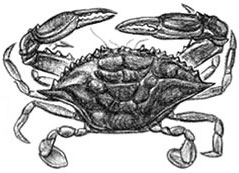Appearance

Scientific Name
Callinectes sapidus
Market Forms
Jimmies (males) and sooks (females) are available in many market forms: whole, live or steamed. Crabmeat is available fresh, frozen and pasteurized, (a process which allows shelf life to be extended without changing taste, appearance or texture). Cocktail claws and numerous value-added products are also available. Picked crabmeat is available in: Jumbo Lump- very large pieces of crabmeat; Backfin- meat coming from the backfin area of the crab; Special or Regular all white flakes of body meat other than the lump; Claw- comes from crab claws; Blended Backfin- combination of backfin and special. Size
Live or steamed, average between 5 to 7 inches across the back of the shell. Meat is available in 8, 12 and 16 oz. cups. Pasteurized meat is available in 8 oz. and 16 oz. containers. Taste/Texture
Sweet, delicate white and light meat. Backfin and Jumbo lump - solid lumps of white meat; perfect for use in recipes where appearance is important. Special or Regular - small pieces of white meat. Claw meat - brownish in color for use in recipes where appearance is less important. Seasonality
Available from March through November, crabs are meatier in the summer and fall months when their feeding activity increases in response to the warmer waters. Nutritional Value
83 Calories (100 grams, 3.5 oz.)
18.1% Protein
1.1% Fat
.32% Omega-3 Folklore
Translation of its Latin name is “beautiful swimmer,”and indeed it is, for its legs allow it to rapidly outdistance its other bottom crawling crab relatives.The blue crab’s common name is equally telling, recognizing the bright blue coloration of its claws.The female of the species is even more vivid, setting off her pincers with bright red tips. Harvesting
Blue crabs are caught in baited “crab pots” throughout the season, which usually runs from March through November. In the winter, when they lie semi-dormant in bottom waters, dredging is the common form of harvesting when permitted.
Safety/Quality
Virginia’s waters and products are regulated by federal and state agencies including the FDA, the Virginia Department of Health, the Virginia Department of Agriculture and Consumer Services, the Virginia Department of Environmental Quality, and the Virginia Marine Resources Commission, insuring that only safe wholesome seafood reaches our customers.

